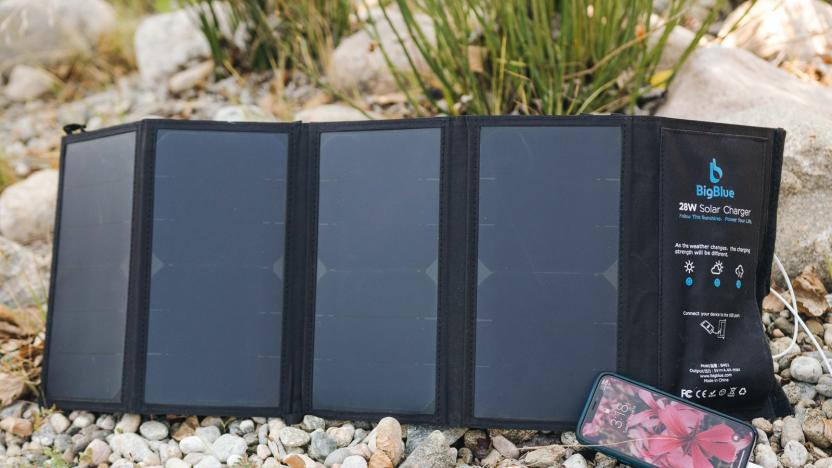bigblue
Latest

The best portable solar battery charger
By Sarah Witman This post was done in partnership with Wirecutter. When readers choose to buy Wirecutter's independently chosen editorial picks, Wirecutter and Engadget may earn affiliate commission. Read the full guide to portable solar battery chargers. Unlike the finite energy stored in a battery pack, a USB solar charger offers a tiny power plant that can generate power for your phone and small electronics to keep them charged when the sun is out—you can even use one to recharge a power bank and save that energy for later. After spending more than 60 hours testing 12 models, we're confident that the BigBlue 28W USB Solar Charger is the best portable solar charger for people who need to charge their gadgets and stay connected in an emergency or when they're off the grid. The BigBlue 28W USB Solar Charger produces the most power of any portable solar charger we've tested, and it has unique features that make it more versatile and durable, including three output ports (versus two on most other chargers), a weatherproof port protector, and an expansive but lightweight array of panels to catch every last ray of sunlight. Although other models come close to matching it in terms of power, the BigBlue is also smaller and lighter than other options with similar output, so it can more easily fit into a camping backpack, hiking daypack, or emergency kit. If the BigBlue is unavailable, we also like the X-Dragon 20W SunPower Solar Charger. In testing, it was second only to our top pick in terms of how much power it produced throughout the day, and it even produced a little more when the sun was at its peak midday. While this model will charge up your devices just as fast as our top pick, the X-Dragon lacks the convenient extras—such as the additional charging port and the port protector—that make the BigBlue stand out.

IBM pushing System z, Power7+ chips as high as 5.5GHz, mainframes get mightier
Ten-core, 2.4GHz Xeons? Pshaw. IBM is used to the kind of clock speeds and brute force power that lead to Europe-dominating supercomputers. Big Blue has no intentions of letting its guard down when it unveils its next generation processors at the upcoming Hot Chips conference: the company is teasing that the "zNext" chip at the heart of a future System z mainframe will ramp up to 5.5GHz -- that's faster than the still-speedy 5.2GHz z196 that has led IBM's pack since 2010. For those who don't need quite that big a sledgehammer, the technology veteran is hinting that its upcoming Power7+ processors will be up to 20 percent faster than the long-serving Power7, whose current 4.14GHz peak clock rate may seem quaint. We'll know just how much those extra cycles mean when IBM takes to the conference podium on August 29th, but it's safe to say that our databases and large-scale simulations won't know what hit them.

Watson now hunting down patent trolls, plans Ken Jennings' elaborate demise
The Watson supercomputer used its speech recognition, natural language processing, machine learning and data mining abilities to crush puny human Ken Jennings' dreams of winning at "Jeopardy!", but now Big Blue has it chasing down medical patent trolls for fun. Incorporating the Strategic IP Insight Platform, IBM has now programmed Watson to scan millions of pharmaceutical patents and biomedical journals to discover, analyze, and record any info pertaining to drug discovery. SIIP can then look for the names of chemical compounds, related diagrams, the company and scientist who invented and works with the compounds and related words to determine a patent's rightful owner. The SIIP function can also highlight which patents could be targeted for acquisition by trolls looking to control a property via a lawsuit or licensing agreement. Click past the break for a video outlining the project, along with Watson's announcement of its engagement to "Skynet".

IBM turns 100, brags about bench pressing more than companies half its age
IBM is quite possibly the only tech company around that might have genuine difficulty whittling a list of its industry defining contributions down to a mere 100. And it's an impressively diverse collection at that, including the floppy disk, the social security system, the Apollo space missions, and the UPC barcode. All of this self-congratulation is not without cause, of course. IBM was born 100 years ago today in Endicott, New York, as the Computing-Tabulating-Recording Company, a merger between three companies, all peddling different technologies. That diversity has helped define IBM from its inception, and has offered a sense of flexibility, making it possible to keep in step with technology's ever-quickening pace for a century. In 1944, the company helped usher in modern computing with the room-sized Automatic Sequence Controlled Calculator, and 37 years later, it played an important role in defining the era of home computing with the much more manageable IBM Personal Computer. In 1997, IBM introduced a machine that beat the world's reigning chess champion, and earlier this year, it created one that trounced two of the greatest players in Jeopardy history. These days, when the company is not building machines dedicated to outsmarting mankind, it's looking to promote sustainable development through its Smarter Planet program. So, happy centennial, Big Blue, and here's to 100 more, assuming your super-smart machines don't enslave us all in the meantime.


